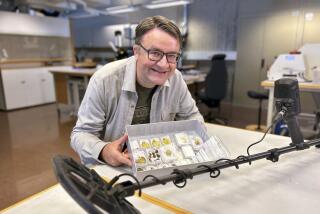Pearl Harvesting Covers 3 Continents
- Share via
I held a pearl as big as a marble, worth $10,000. On the table before me, in a pearl shop in Broome, Australia, more lustrous pearls lay shining on a tray. The “peeler,” who cleans and shapes the raw pearls into jewels, could recognize each individual pearl he had worked.
He was so familiar with the pearls they might have been born from his hands. But, in fact, these Pacific pearls began life thousands of miles away in the Mississippi region of the United States. Their travels tell a tale of economic interdependence that spans a century and three continents.
Pearls, of course, are legendary riches, coveted for their rarity and beauty, the one-in-a-thousand natural treasure hidden inside an oyster’s shell. Yet, the pearl begins as nothing but a nuisance to the oyster. If an oyster cannot eject an irritant--for example, the proverbial grain of sand or a bit of coral--it will neutralize the annoying artifact by surrounding it with a secretion of calcium carbonate and aragonite, the same material that forms the oyster’s shell.
What soothes the oyster also forms the pearl, as this coating or nacre builds and hardens around the original core. The process can take a decade or longer.
In western Australia, a natural pearling industry boomed in the late 1800s. Australian boat owners recruited Aboriginal, Malaysian and Japanese divers, who risked their lives over the decades to pluck oysters from the sea. Many died in diving accidents or from shark attacks.
By 1930, Japanese-owned vessels had begun pearling as well, taking huge amounts of mother-of-pearl shells and pearls from Australian waters. But shortly thereafter, the swelled market supply and advent of plastic buttons drove down the price of pearl shell, and the industry faded away.
After World War II, Australian pearlers were eager for a comeback. By 1945, the Japanese had developed a highly lucrative pearl-culturing industry. So, as a war reparation, the Australians requested the pearling expertise of the Japanese.
Interestingly, the Japanese master pearlers said the warm, clear waters of Australia would grow pearl oysters larger than the best Japan could produce. Thus a surprising cooperation emerged. That cooperative effort spread to include the North American continent.
Instead of the natural “grain of sand” irritant, Broome oysters are today meticulously seeded with a bit of shell from a freshwater mussel found across the world. According to exporter James Peach, his mussel shells are found in freshwater streams or lakes in the drainage basin of the Mississippi. The shells travel by train to Kansas City and on to California. Then they are shipped to the Orient, where round beads are cut from the mussel shell and forwarded to Australia. There, young oysters are delicately removed from the bottom of the sea, placed in mesh rafts and reset in the seabed. They are given about a year to acclimatize, then the surgery begins.
A live oyster naturally keeps its lips slightly open, and the pearl seeder slips a disinfected scalpel inside. The seeder then clips away pieces of oyster flesh--each a few millimeters square. Each piece is wrapped around a well-traveled Mississippi nucleus and re-inserted delicately into the original oyster, plus two others, thus tripling the potential yield.
The seeded oysters are then returned to their basket trays and lowered into the warm, nurturing sea. The freshwater nucleus is not rejected by the oyster, which is otherwise extremely efficient at filtering food from the other detritus in the water.
Several months later, the seeded oysters are raised and X-rayed to see if the pearl process is under way. About 83% of the grafts are successful, but only about 35% produce good, round pearls. When a quality pearl is produced, it is removed. Great care is taken to ensure that the oyster is not harmed during the process, since it may be used again.
However, later the oyster may produce only a half-pearl, which adheres to the shell and must be sawed out, in the process killing the oyster. According to information I received, though, this oyster meat is sold on the Asian market and waste is minimal.
I was fascinated by the careful harvesting techniques that had replaced the boom-bust cycle that once depleted the pearl beds--a wise approach to resource management embraced in the single perfect pearl in my hand.
More to Read
Sign up for The Wild
We’ll help you find the best places to hike, bike and run, as well as the perfect silent spots for meditation and yoga.
You may occasionally receive promotional content from the Los Angeles Times.






